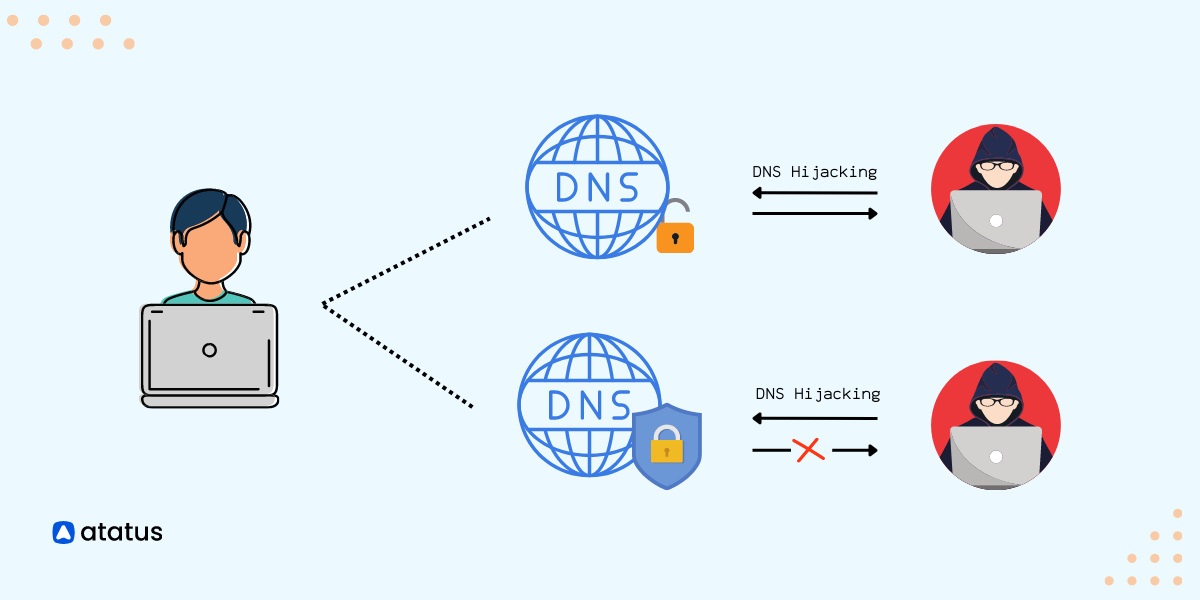Top DNS Monitoring Tools [2025 Guide]
The modern business heavily depends on an active online presence for customer engagement and revenue generation. But have you ever stopped to think about what makes these online services accessible to users around the world? Enter the Domain Name System (DNS), a crucial component of the internet infrastructure that translates domain names into IP addresses and directs traffic to the appropriate server.
DNS monitoring tools are the defenders that safeguard the internet infrastructure from unwanted downtime, latency, and security breaches. But what makes DNS monitoring tools so critical?
For starters, they provide real-time visibility into DNS resolution times, DNS response times, and DNS errors. They help organizations detect issues before they impact users, allowing them to take proactive measures to resolve them.
Moreover, DNS monitoring tools can help organizations prevent DNS-based cyber attacks such as cache poisoning and DDoS attacks. They ensure the stability, availability, and the security of online services, enabling businesses to operate smoothly and engage with customers on a global scale. Without them, the internet as we know it would be a much less reliable and secure place.
Table of Contents:
- Atatus
- Nagios
- Datadog
- SolarWinds
- Zabbix
- Paessler PRTG Network Monitor
- ManageEngine Applications Manager
- Dotcom-monitor
1. Atatus
Atatus is a performance monitoring platform that provides DNS monitoring as one of its features. Atatus DNS monitoring helps users monitor the health and performance of their DNS infrastructure, ensuring that their applications are always available and responsive to their end-users.
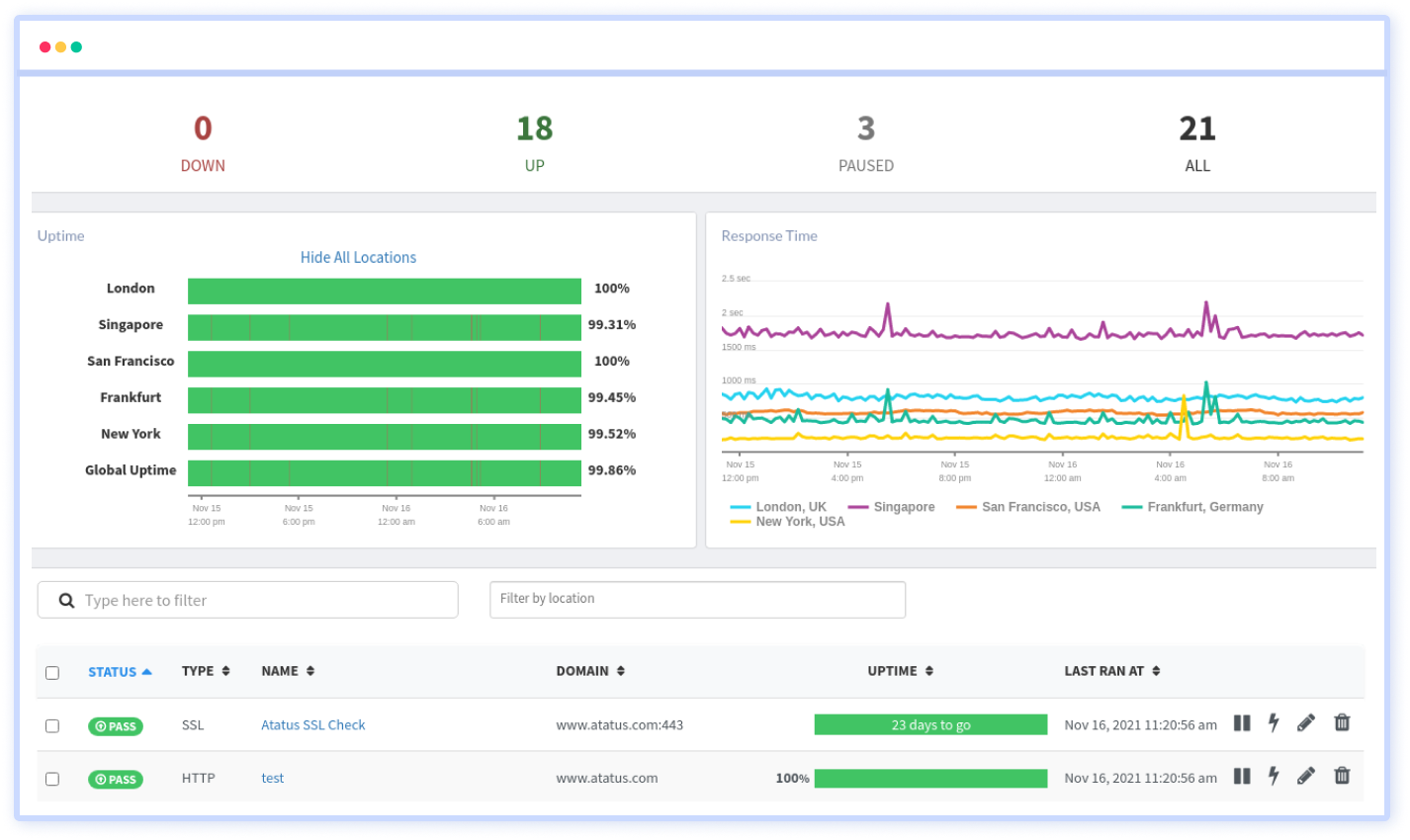
Features:
- Atatus DNS Monitoring offers 24/7 support to help you troubleshoot issues and ensure that your domain's DNS infrastructure is always up and running.
- It provides an API that allows you to programmatically access monitoring data, enabling integration with your existing monitoring and alerting tools.
- Atatus DNS Monitoring provides detailed analysis of query response times, allowing you to identify performance bottlenecks and optimize your domain's DNS infrastructure.
- It is easy to set up and requires no special configuration or hardware, making it a simple and cost-effective way to monitor your domain's DNS infrastructure.
2. Nagios
Nagios is an open-source network monitoring tool that is widely used for monitoring and alerting on system and application performance issues. It can monitor a wide range of network devices, services, and protocols, including DNS servers.
Nagios has a large community of users and developers. It also has a web-based interface for managing and configuring monitoring checks, and provides detailed reporting and visualization of monitoring data.

Features:
- Nagios provides detailed reporting and visualization of DNS monitoring data, including graphs, charts, and dashboards.
- Nagios can also monitor DNS records, including A records, MX records, and PTR records, to ensure they are resolving correctly and not experiencing any issues.
- Nagios can alert system administrators when DNS issues are detected, using a variety of methods, including email, SMS, and custom scripts.
- Nagios can be integrated with other tools and systems, such as log management systems, to provide more comprehensive DNS monitoring and troubleshooting capabilities.
Cons:
- Limited scalability
- Complex and has a steep learning curve
3. Datadog
Datadog DNS Monitoring is a cloud-based network monitoring tool that provides real-time visibility into an organization's DNS infrastructure. Datadog DNS Monitoring can detect DNS-related issues and provide alerts for potential problems.

Datadog DNS Monitoring provides DNS analytics, allowing organizations to identify trends and patterns in DNS traffic. One of the key benefits of Datadog DNS Monitoring is that it is a cloud-based tool, which means that organizations can monitor their DNS infrastructure from anywhere with an internet connection. The tool is also easy to use and can be set up quickly, allowing organizations to start monitoring their DNS infrastructure in minutes.
Features:
- Provides real-time visibility into an organization's DNS infrastructure, allowing them to monitor DNS servers and ensure their availability, performance, and security.
- Tracks DNS queries and responses to identify slow or failed queries.
- Provides a user-friendly interface that makes it easy for organizations to set up and use the tool.
Cons:
- Cost can be expensive, especially for small businesses or organizations with limited budgets.
4. SolarWinds
SolarWinds DNS monitoring is a cloud-based DNS monitoring and management tool that offers a range of features to help you monitor and troubleshoot DNS-related issues. SolarWinds DNS monitoring provides detailed reports and analysis of DNS-related metrics.
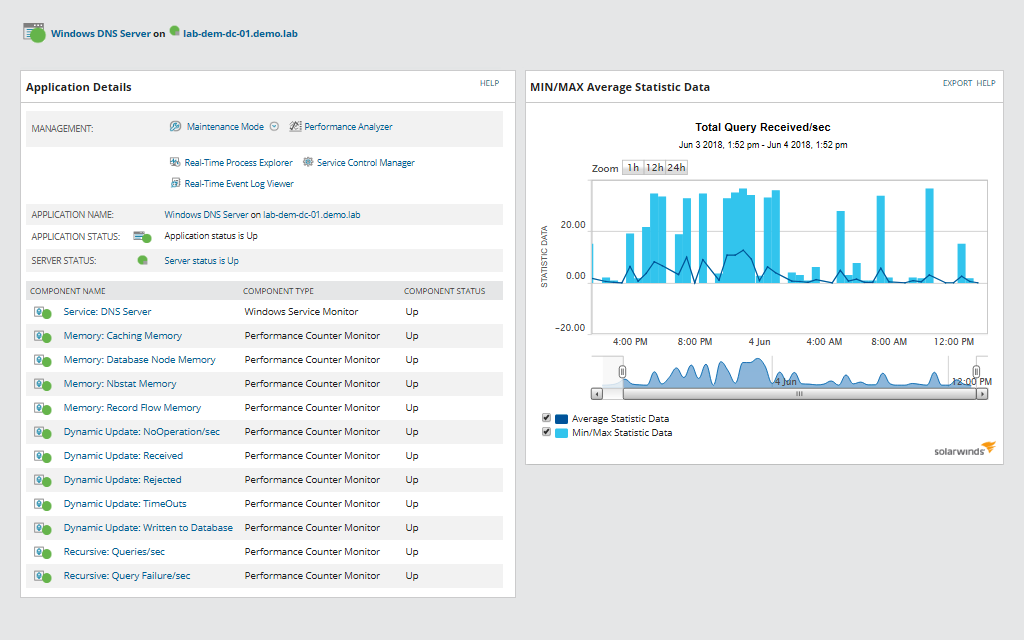
You can view metrics such as DNS query rate, response time, and cache hit rate, which can help you identify performance bottlenecks and troubleshoot issues.
Features:
- DNS health checks: SolarWinds DNS monitoring can perform regular DNS health checks to identify any potential issues with your DNS servers or configurations.
- DNS troubleshooting: The tool provides in-depth DNS troubleshooting capabilities to help you identify and resolve DNS-related issues quickly.
- DNS propagation testing: The tool can simulate DNS record propagation across different global locations to ensure that your DNS records are being served correctly.
- DNS zone management: SolarWinds DNS monitoring includes features to help you manage DNS zones more efficiently, such as zone file analysis and zone file backup and restore.
Cons:
- Complex and high cost
- Limited free trial
5. Zabbix
Zabbix is a comprehensive open-source network monitoring tool that offers a wide range of features for monitoring and managing IT infrastructure. The tool can be deployed on various operating systems, and it supports multiple monitoring methods, including agent-based, agent-less, and SNMP. This means that administrators can use Zabbix to monitor DNS servers regardless of the platform they're running on.

Features:
- Web monitoring: Zabbix can monitor web applications and services, including HTTP, HTTPS, and SSL.
- Visualization: It provides various visualization options, including graphs and screens, that allow administrators to view DNS performance data in real-time.
- Auto-discovery: It can automatically discover DNS servers and services, which can save administrators time and effort.
Cons:
- Steep learning curve: Zabbix has a steep learning curve, and it can take time to configure and customize the monitoring templates.
- No support for non-IP-based devices: Zabbix does not support non-IP-based devices, which can be a limitation for some organizations.
6. Paessler PRTG Network Monitor
PRTG Network Monitor provides a comprehensive DNS monitoring solution that allows administrators to monitor DNS servers in real-time and receive alerts if there are any issues with the servers.
Despite being recognized mainly as a network monitoring tool, Paessler PRTG has the capacity to function as a robust DNS monitoring solution.
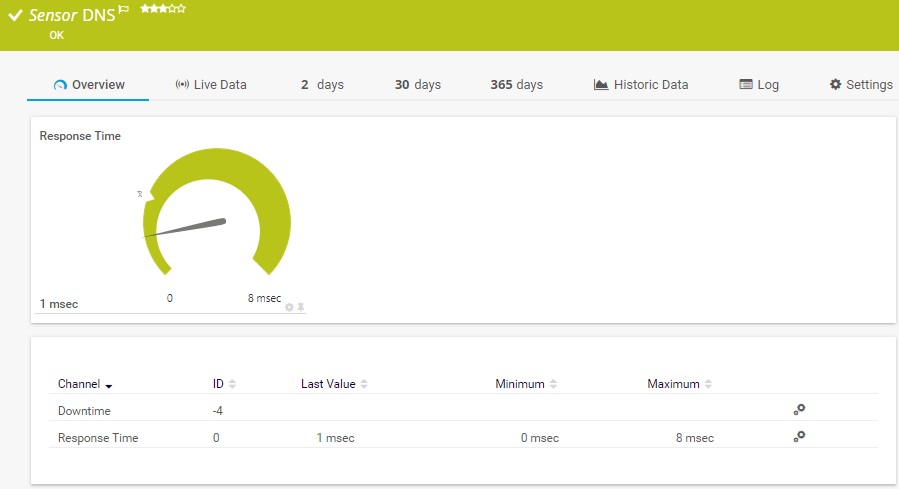
PRTG stands out because it strikes a balance between providing the necessary information for effective network monitoring and avoiding an excess of irrelevant data. As a result, PRTG enables users to acquire essential insights for network monitoring while avoiding an overwhelming amount of information. PRTG can store historical data on DNS queries and responses, which can be used for trend analysis and troubleshooting purposes.
Features:
- DNS cache monitoring: PRTG Network Monitor can monitor DNS cache servers to ensure they are functioning optimally and not causing any network issues.
- DNS record monitoring: PRTG Network Monitor can monitor DNS record changes to ensure that they are properly propagated throughout the network and that there are no discrepancies or errors.
- DNS zone monitoring: PRTG Network Monitor can monitor DNS zones to detect any issues or errors that may impact network performance.
Cons:
● Sensor-based pricing model
● Limited scalability
7. ManageEngine Applications Manager
ManageEngine Applications Manager is a powerful application performance monitoring solution that offers robust DNS monitoring capabilities to help IT teams ensure the availability and performance of their DNS servers and related services.
The platform also offers DNS server availability monitoring, which can alert IT teams in the event of any downtime or performance issues, and DNS cache monitoring, which can optimize DNS response times by ensuring that responses are served from the cache as much as possible.
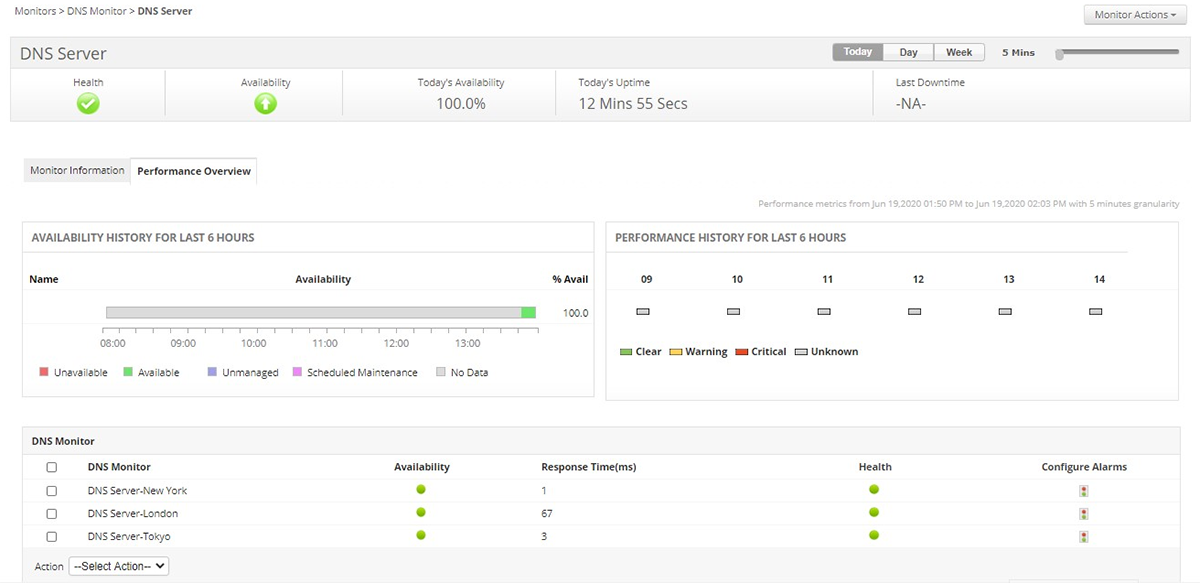
Whether you're managing a small network or a complex enterprise environment, ManageEngine Applications Manager can help you stay on top of your DNS infrastructure and ensure the optimal performance of your business-critical applications.
Features:
- and performance of DNS servers in real-time, ensuring that they are performing optimally.
- DNS record monitoring: Applications Manager can monitor the availability and response time of DNS records, ensuring that they are resolving properly and not causing any network issues.
- DNS zone monitoring: Applications Manager can monitor DNS zones to detect any issues or errors that may impact network performance.
- DNS query monitoring: Applications Manager can monitor DNS queries to detect any issues or errors that may impact network performance.
8. Dotcom-monitor
Dotcom-monitor DNS monitoring tool is a software solution designed to monitor the Domain Name System (DNS) performance and availability of websites, applications, and online services. It helps organizations to detect and resolve DNS-related issues before they impact end-users.

Features:
- Monitoring of DNS resolution times, DNS response times, and DNS errors.
- Automated testing of DNS infrastructure across multiple global locations.
- Real-time alerts and notifications when DNS issues are detected.
- Comprehensive reporting and analytics to help identify trends and patterns in DNS performance.
- Support for a variety of DNS record types, including A, MX, NS, TXT, CNAME, and SRV records.
- Integration with other monitoring tools and systems for a comprehensive view of website and application performance.
Case Study
In October 2016, the internet experienced a massive Distributed Denial of Service (DDoS) attack that targeted the Domain Name System (DNS) infrastructure. The attack, which was orchestrated against the DNS provider Dyn, affected multiple high-profile websites and services such as Twitter, Netflix, and Reddit, causing widespread internet outages.
The DDoS attack targeted the DNS infrastructure, which is responsible for translating domain names into IP addresses and directing internet traffic to the appropriate servers. The attackers flooded the DNS servers with a massive amount of traffic, overwhelming the servers and causing DNS resolution failures.
Attack Scenario
The attack was carried out using a botnet, which is a network of compromised computers that can be controlled remotely. The botnet, known as Mirai, was designed to target Internet of Things (IoT) devices, such as routers and cameras, that were easily hackable due to their weak security configurations.
The attackers used the Mirai botnet to launch a massive DDoS attack against Dyn's DNS infrastructure, which ultimately caused widespread internet outages and disruption.
Impact of the attack
- Website downtime: The attack caused many high-profile websites and services, such as Twitter, Netflix, and Reddit, to become unavailable for several hours. This downtime resulted in lost revenue for the affected companies and frustration for users.
- Economic losses: The attack caused significant financial losses for the affected companies, with estimates ranging from hundreds of thousands to millions of dollars in revenue losses.
- Reputational damage: The attack also had a negative impact on the reputation of the affected companies, with many users expressing frustration and concern about the security and reliability of the internet.
- Concerns about cybersecurity: The attack raised serious concerns about the security of the internet's infrastructure and the potential for similar attacks in the future. It also highlighted the need for increased investment in cybersecurity and DNS security measures.
Measures taken
In response to the DDoS attack on Dyn's DNS infrastructure, the company took several measures to restore DNS services and mitigate the impact of the attack. Dyn quickly increased server capacity and worked with upstream providers to filter out the malicious traffic and prevent it from reaching its servers.
Dyn also implemented new security measures, including improving its DDoS mitigation capabilities and implementing additional security protocols to protect against botnet attacks. However, the attack highlighted the need for increased investment in DNS security and cybersecurity measures to ensure the stability and resilience of the internet's infrastructure.
Importance of DNS monitoring
DNS monitoring is critical in the context of the 2016 DDoS attack on Dyn, as it can help detect and prevent similar attacks in the future. In the case of the Dyn attack, DNS monitoring could have helped Dyn detect the attack early on and take proactive measures to mitigate its impact. For example, DNS monitoring could have alerted Dyn to the unusually high volume of traffic directed at its DNS servers, allowing the company to take steps to filter out the malicious traffic and prevent it from overwhelming its servers.
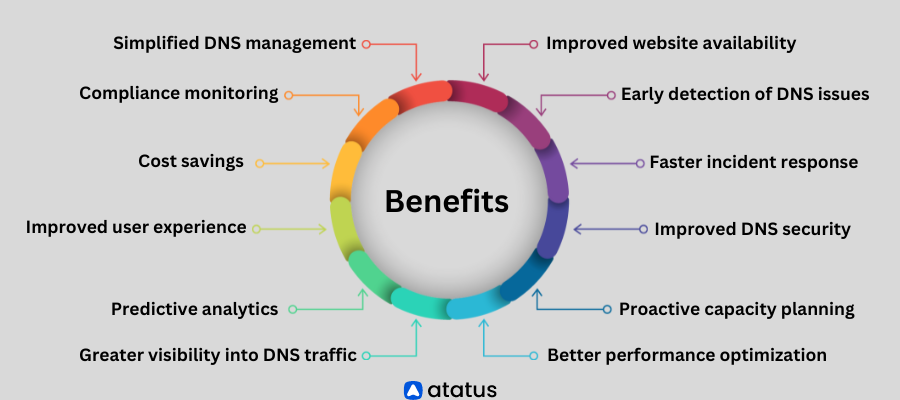
DNS monitoring can also help organizations identify vulnerabilities in their DNS infrastructure and take steps to improve their overall DNS security posture. By regularly monitoring their DNS infrastructure, organizations can identify and address potential weaknesses, such as outdated software or misconfigured settings, before they can be exploited by attackers.
Conclusion:
DNS monitoring tools are a crucial component of any organization's cybersecurity strategy, providing real-time visibility and control over their DNS infrastructure.
By detecting and mitigating DNS-related threats, improving website availability and performance, and simplifying DNS management, DNS monitoring tools can help organizations stay ahead of the ever-evolving threat landscape and deliver a seamless online experience to their users.
As the importance of online services and e-commerce continues to grow, DNS monitoring tools will only become more critical in ensuring the stability, security, and availability of the internet.
Global DNS Monitoring with Atatus
Atatus offers DNS Synthetic Monitoring feature that helps users monitor the performance and availability of their DNS servers. It helps users ensure that your DNS servers are performing optimally, reducing the risk of website downtime and slow response times, and providing a reliable and fast experience for their users.
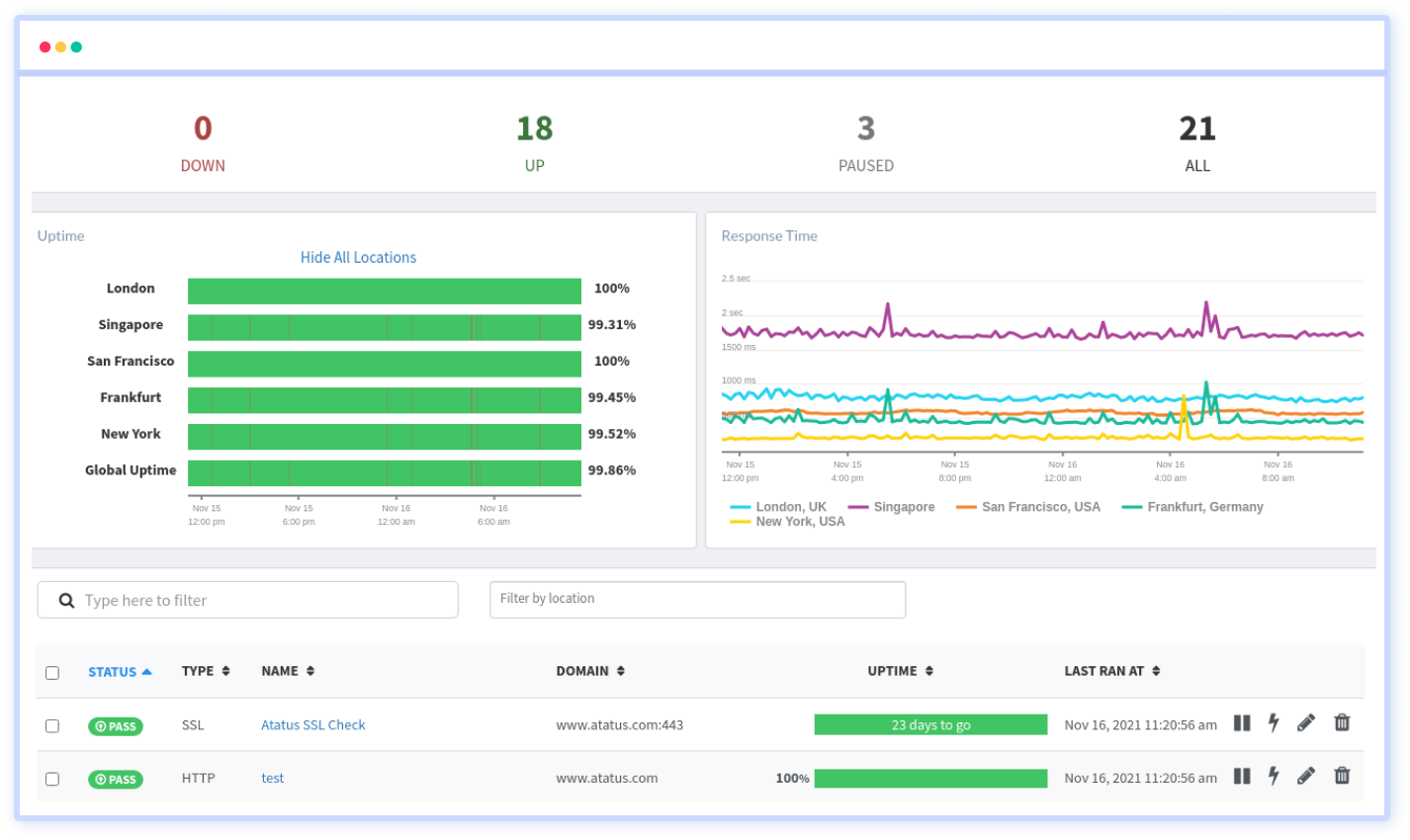
With Atatus DNS Monitoring, users can monitor their DNS servers from multiple locations worldwide to ensure that their domain names are resolving correctly and quickly. This feature allows users to:
- Monitor DNS uptime and response time: Atatus monitors the availability and performance of DNS servers and alerts users if there are any issues.
- Troubleshoot DNS issues: Atatus provides detailed information on DNS queries and responses, allowing users to quickly identify and fix any issues.
- Test DNS from multiple locations: Atatus tests DNS resolution from multiple locations worldwide, providing users with a global view of their DNS performance.
#1 Solution for Logs, Traces & Metrics
APM
Kubernetes
Logs
Synthetics
RUM
Serverless
Security
More

![Top DNS Monitoring Tools [2025 Guide]](/blog/content/images/size/w960/2023/05/dns-monitoring-tools-1-.png)

